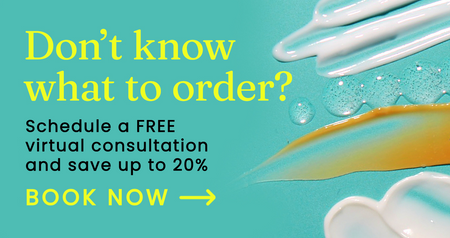Can Niacinamide Help Treat Acne?

Have you ever had a blemish pop up at the worst possible moment? We’ve been there. It’s always right before a date, a nice dinner or an important presentation. You can cover it with a high-coverage foundation, but it’ll ultimately still be there.
Of all the skincare ingredients that promise to kick your blemishes to the curb, Niacinamide consistently delivers. This powerful ingredient uses a four-pronged approach to beat your blemishes.
What Is Niacinamide?
Niacinamide is a form of Vitamin B3, although it’s not to be confused with another form of B3 called Niacin. These two ingredients are similar but aren’t quite interchangeable. You may also see Niacinamide listed as Nicotinamide.
Niacinamide occurs naturally in various fruits, vegetables and meats. It’s a vitamin that is necessary for your skin and overall health, but your body doesn’t keep it around — unused Vitamin B leaves your body at the end of every day.
Because of this, you have to continuously take in Vitamin B to make sure your stores are filled. You can do this by eating foods rich in Vitamin B, but there’s no way to guarantee that dietary Vitamin B actually makes it into your skin.
To make sure you get a good amount of Vitamin B in your skin, you can apply topical Vitamin B (AKA Niacinamide) regularly. But why do you want Niacinamide in your skin?
Topical Niacinamide is exceptional at supporting and promoting healthy-looking skin. This skincare ingredient is commonly prescribed by dermatologists to reduce the appearance of blemishes, fine lines, dark spots and dry skin
How Can Niacinamide Reduce Blemishes?
Blemishes come about for several reasons.
Sometimes it’s oil-clogged pores, sometimes it’s dryness, sometimes it is just acne-prone skin and sometimes it’s free-radical damage. Whatever the reason, blemishes and breakouts are pesky little nuisances that show up at the worst times.
Here’s how Niacinamide can help reduce the appearance of those blemishes and nip other skin concerns right in the bud.
Infuses Hydration
One of the ways your skin keeps itself hydrated is through its lipid barrier, also known as your skin barrier. The lipid barrier sits on top of your outermost layer of skin (called the epidermis) and acts as a brick wall. This brick wall prevents bacteria and germs from coming in and keeps water from going out — not to mention the fact that it also helps protect your skin from environmental damage.
If your skin barrier is compromised, your skin’s moisture can evaporate. This can lead to dry skin and those dreadful blemishes.
Dry skin is characterized by red, flaky, and irritated skin. Fortunately, Niacinamide works to support and nourish that lipid barrier so that you can keep the moisture you put in your body.
Properly moisturized skin is better able to regulate itself, potentially leading to fewer blemishes (and improved skin health) on your part.
Reduces Oil Production
The oil on your skin (AKA sebum) is part of your skin’s hydration mechanism. Your sebum production is what keeps your skin soft and youthful.
Sometimes, the sebaceous glands that produce your sebum kick into overdrive. This is when your pores can get clogged with oil, and you start to see an oily sheen on your face.
Clogged pores get irritated and red and can even develop infections if bacteria are involved. This is what causes those blemishes that show up now and then.
Luckily, Niacinamide can help target blemishes at their source by helping your skin maintain healthy oil production and balance. This benefit is perfect for anyone with oily skin that is particularly prone to blemishes.
With your oil production in check, you can rest assured that blemishes will have a hard time popping up unexpectedly.
Nourishes Skin
Niacinamide can help soothe your skin after sun damage by delivering hydration and working to combat the appearance of hyperpigmentation.
Sun damage can contribute to dark spots, sun damage, fine lines and blemishes. Niacinamide helps protect against all of these and works to nourish the skin after the fact. This little ingredient does it all!
Even though Niacinamide can help nourish your skin after sun damage, it’s no replacement for SPF. You should still apply a sunscreen of at least SPF 30 every morning and every two hours throughout the day. Sun damage is no joke.
Fades Discoloration
Lastly, Niacinamide can help reduce the appearance of blemishes by soothing irritation and fading ghosts of pimples past for a more even-looking skin tone.
Niacinamide acts by soothing the irritation that causes red, angry blemishes. It calms the skin and keeps the redness down.
This powerful skincare ingredient can also work to fade scars. We love our skin, but blemishes don’t need to make a front-and-center cameo appearance. Blemish scars are pesky and often hard to get rid of; however, Niacinamide may eventually reduce their appearance.
What Is the Best Niacinamide Skincare Routine?
Niacinamide is a skin-supporting powerhouse, so you might want to incorporate it into every part of your routine. If you do, we certainly understand why!
Here’s our favorite Niacinamide-infused skincare routine.
Step One: Cleanser
Start with our Even Tone Cleansing Bar to remove any dirt or leftover makeup. This bar comes with a sponge to lightly exfoliate your skin as well, which means your other products can soak into your skin more easily.
Our cleanser also contains Niacinamide as a key ingredient so that you can incorporate this ingredient into every step of your skincare routine.
Step Two: Toner
Toner is optional, but we recommend putting it on after your cleanser if you do decide to use it. Toners are mainly used to remove any remaining dirt while also providing an additional layer of product. Not everyone uses toners, but they can have a noticeable difference in the brightness of your skin.
We recommend our Witch Hazel Brightening & PH Balancing Toner. This toner is infused with antioxidants to help your skin look bright, and it also uses Niacinamide to restore balance gently.
Step Three: Serum
Serums should come after toner but before moisturizer. This is because serums usually have the most concentrated skincare ingredients, and they need to go on clean skin to be the most effective. Also, applying moisturizer after a serum helps lock that serum against your skin to keep its magic ingredients working all day or night long.
We would be remiss if we didn’t let you in on our little not-so-secret: our Even Tone Super Glow Serum. You know we are all about that glow, and this serum is designed to deliver. With Niacinamide, Kojic Acid and Vitamin C, this serum is bright, even-looking skin in a bottle.
Step Four: Moisturizer
Your moisturizer should be formulated for your exact skin type. Otherwise, you risk irritation.
Moisturizers designed for oily skin likely won’t provide the deep moisture that dry skin needs, while moisturizers designed for dry skin will likely cause more oil production in oily skin.
A good middle-ground moisturizer is our Complexion Protection Moisturizer With SPF 30. This moisturizer is a fan favorite because it’s lightweight, non-comedogenic (meaning it won’t clog your pores) and doubles as a daily sunscreen.
Step Five: Sunscreen
If you don’t have a moisturizer that doubles as sunscreen, then sunscreen will be your final step. Niacinamide can help reduce your risk of sun damage, but it’s not nearly as effective as a sunscreen. Ideally, you should use the two together to create stronger protection.
Your sunscreen should also fit your skin type. Most sunscreens should fit dry skin since they are thicker. If you have oily skin, look for a sunscreen that says “oil-free” or “for oily skin.”
Tips & Tricks
Finally, our Licensed Aestheticians have a few last tips and tricks to help you get the most out of your Niacinamide skincare.
Consistency Is Key
As with most other over-the-counter skincare products, Niacinamide takes time to show results. It may be tempting to get impatient, but give it time. You should start seeing results within 3-4 weeks if you’re using your product regularly.
Start Slow
Lower your risk of irritation by starting slow, especially if you have sensitive skin. Introduce Niacinamide into your skincare routine every other night, and slowly work your way up to nightly use.
Talk to an Expert
If you have any concerns or notice any abnormal irritation, it doesn’t hurt to contact your dermatologist. If you have any questions about one of our products, you can also schedule a virtual consultation with one of our Licensed Aestheticians.
In Conclusion
Niacinamide is a derivative of Vitamin B3 and can be found in nature and in the food you eat. Niacinamide is not made naturally by the human body, so it is important to make sure you get enough of this vitamin from your diet.
When used topically, Niacinamide can help reduce the appearance of blemishes by keeping your skin hydrated, protecting your skin against damage and fading blemish-related scars.
For more skincare tips and tricks, visit our Glow-Up Guide and follow us on social media.
Service Representative




